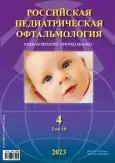Clinical features and results of surgical treatment of congenital corneal opacities in infants and children under 3 years of age
- Authors: Pleskova A.V.1, Panova A.Y.1
-
Affiliations:
- Helmholtz National Medical Research Center of Eye Diseases
- Issue: Vol 18, No 4 (2023)
- Pages: 185-190
- Section: Original study article
- URL: https://journals.rcsi.science/1993-1859/article/view/163925
- DOI: https://doi.org/10.17816/rpoj569148
- ID: 163925
Cite item
Abstract
Congenital corneal opacities (CCO) are rare eye anomalies of various etiological causes. Given the heterogeneity of the clinical and morphological manifestations of CCO, its functional disorders are of the same type and significant, leading to visual disability. This anomaly occurs in 6 per 100,000 newborns.
AIM: To study the clinical and anatomical features and treatment results of CCO in children aged under 3 years old, who were treated in the Department of Eye Pathology in Children of Helmholtz National Medical Research Center of Eye Diseases for the period from January 1, 2010, to December 31, 2022 (12 years).
MATERIAL AND METHODS: The clinical and anatomical features and results of surgical treatment of 142 patients (172 eyes) with CCO aged 0–3 years were analyzed in the period from January 1, 2010, to December 31, 2022. According to the clinical picture, all CCOs were classified as congenital glaucoma, sclerocornea, Peters anomaly, anterior staphyloma, endothelial corneal dystrophy, dermoid, and Axenfeld–Rieger syndrome, and were idiopathic. Surgical methods included end-to-end keratoplasty, layered keratoplasty, limbokeratoplasty, and end-to-end reconstructive keratoplasty, including synechial excision, cataract removal, pupil formation, and anterior vitrectomy. The treatment results were evaluated based on the biological and functional results. The biological results of the operation (graft engraftment) were evaluated in the Kaplan–Meier model.
RESULTS: Congenital glaucoma dominates among clinical diagnoses of CCO (40% of all cases), followed by Peters anomaly, sclerocornea, congenital hereditary endothelial corneal dystrophy, other hereditary corneal dystrophies and anterior staphyloma, Axenfeld–Rieger syndrome, and corneal dermoid. In 5 (3%) cases, the CCO was defined as idiopathic. Surgical treatment was performed on 78 (86 eyes) out of 142 (54.9%) patients. The 1-year survival rate following transplants in patients with high blood pressure was 75%; with Peters anomaly, 67%; and with sclerocornea, 54%, and the 2-year survival rates were 70%, 63%, and 36%, respectively. The 1 and 2 years urvival rates following transplants in patients with congenital endothelial hereditary dystrophy were 88 and 82%, respectively.
CONCLUSION: The results show that CCO manifest heterogeneously in children aged under 3 years old. Careful anamnesis collection, thorough clinical examination, and additional studies such as UBM are crucial in obtaining accurate diagnosis and classification of CCO and provide recommendations on treatment strategies.
Full Text
##article.viewOnOriginalSite##About the authors
Alla V. Pleskova
Helmholtz National Medical Research Center of Eye Diseases
Email: dho@igb.ru
ORCID iD: 0000-0002-4458-4605
MD, Dr. Sci. (Med.)
Russian Federation, MoscowAnna Yu. Panova
Helmholtz National Medical Research Center of Eye Diseases
Author for correspondence.
Email: annie_panova18@mail.ru
ORCID iD: 0000-0003-2103-1570
MD, Cand. Sci. (Med.)
Russian Federation, MoscowReferences
- Shigeyasu C., Yamada M., Mizuno Y., et al. Clinical features of anterior segment dysgenesis associated with congenital corneal opacities. Cornea. 2012;31(3):293–298. doi: 10.1097/ICO.0b013e31820cd2ab
- Cotran PR, Bajart AM. Congenital corneal opacities. Int Ophthalmol Clin. 1992;32(1):93–105. doi: 10.1097/00004397-199203210-00010
- Rezende RA, Uchoa UB, Uchoa R, et al. Congenital corneal opacities in a cornea referral practice. Cornea. 2004;23(6):565–570. doi: 10.1097/01.ico.0000126317.90271.d8
- Bermejo E, Martínez-Frías ML. Congenital eye malformations: clinical-epidemiological analysis of 1,124,654 consecutive births in Spain. Am J Med Genet. 1998;75(5):497–504.
- Shi W, Jin H, Li S, et al. Indications of paediatric keratoplasty in north China. Clin Exp Ophthalmol. 2007;35(8):724–727. doi: 10.1111/j.1442-9071.2007.01618.x
- Zhang Y, Liu Y, Liang Q, et al. Indications and Outcomes of Penetrating Keratoplasty in Infants and Children of Beijing, China. Cornea. 2018;37(10):1243–1248. doi: 10.1097/ICO.0000000000001695
- Dale NJ, Tadic V, Sonksen P. Social communicative variation in 1-3-year-olds with severe visual impairment. Child Care Health Dev. 2014;40(2):158–164. doi: 10.1111/cch.12065
- Katsman LR, Reiser BJ. Pediatric corneal opacities. San Francisco; 2016.
- Sonksen PM, Dale N. Visual impairment in infancy: impact on neurodevelopmental and neurobiological processes. Dev Med Child Neurol. 2002;44(11):782–791. doi: 10.1017/s0012162201002936
- Arffa RC. Congenital anomalies. In: Arffa RC, editor. Grayson’s diseases of the cornea. St. Louis: Mosby-Year Book; 1997.
- Mataftsi A, Islam L, Kelberman D, Sowden JC, Nischal KK. Chromosome abnormalities and the genetics of congenital corneal opacification. Mol Vis. 2011;17:1624–1640.
- Maillette de Buy Wenniger-Prick LJ, Hennekam RC. The Peters’ plus syndrome: a review. Ann Genet. 2002;45(2):97–103. doi: 10.1016/s0003-3995(02)01120-6
- Ozeki H, Shirai S, Nozaki M, et al. Ocular and systemic features of Peters’ anomaly. Graefes Arch Clin Exp Ophthalmol. 2000;238(10):833–839. doi: 10.1007/s004170000177
- Townsend VM. Congenital anomalies of the cornea. In: Kaufman HE, Baron BA, MacDonald MB, editors. The cornea. 2nd edition, CD-ROM. London: Butterworth-Heinemann; 1999.
- Zaidman GW, Flanagan JK, Furey CC. Long-term visual prognosis in children after corneal transplant surgery for Peters anomaly type I. Am J Ophthalmol. 2007;144(1):104–108. doi: 10.1016/j.ajo.2007.03.058
- Nischal KK, Naor J, Jay V, et al. Clinicopathological correlation of congenital corneal opacification using ultrasound biomicroscopy. Br J Ophthalmol. 2002;86(1):62–69. doi: 10.1136/bjo.86.1.62
- Nischal KK. Genetics of Congenital Corneal Opacification — Impact on Diagnosis and Treatment. Cornea. 2015;34(Suppl 10):S24–S34. doi: 10.1097/ICO.0000000000000552
Supplementary files







